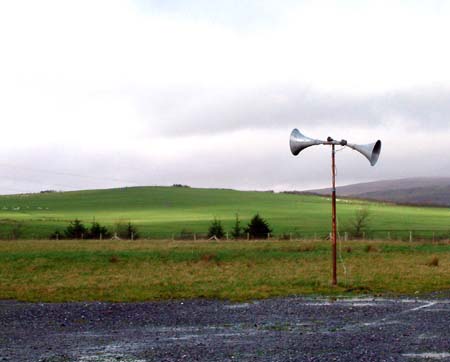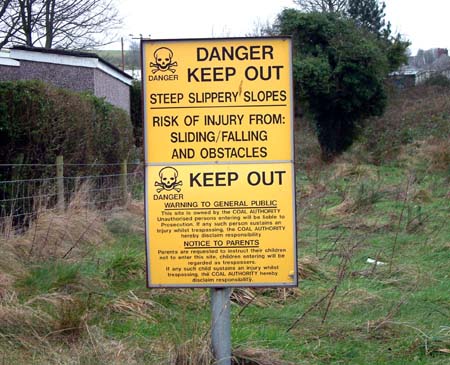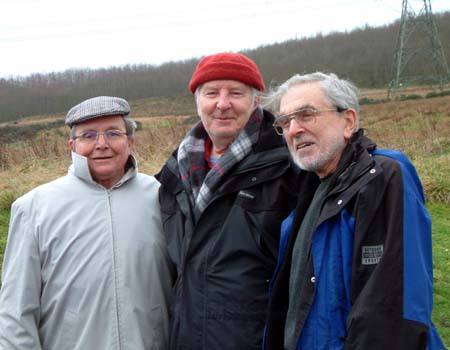Banwen Pyrddin, pit village
with today no sign of a pit, turns out to be nothing like I had imagined.
A couple of streets centred on Roman Road, a terrace of sixty four
houses, so badly maintained by the NCB when they were in charge that
one fell down so now there's sixty three. I'm driving round with George
Brinley Evans, former collier, author and eighty-two year old local
celebrity, strung about with cameras to record my visit, and top coats
to keep out the driving rain. We're in Norman Burns' battered Nissan.
The springs are squashed by our combined weight. Norman is the secretary
of the local history society and can tell you the past of almost every
stone. Morgan, delighted the fog has lifted and who has got me up
here to show me the places of his childhood, turns out to be known
locally as Brian. We reach the top of the village. It's taken us about
five seconds. End house is boarded up, the one next to it has a large
and dopy Alsatian spread out on the inside window ledge like a cat.
Midday. Upstairs a vision in pink tracksuit, fag in hand, has just
got up. A man in a cowboy hat comes out to start a car, fails, then
immediately gives up. The rain comes in along Roman Road like an army
of legionnaires. This was once Sarn Helen, clattering into Banwen
from the fort at Coelbren then roaring out, up over Hirfynydd to the
rest of the civilised world. Except that in those days there was no
Banwen, nothing. Almost like now, not even a scrape in the ground.

We've been up on the mountain
at Clwdi Banwen to see the famous fake rocks, the Gnoll
Stones , high in the rained-on forestry. The fakes are of a fifth
century memorial pillar stone marking the burial of Macaritinus son
of Bericius and of a pre-Norman wheel cross
showing a man in a kilt . The originals are now
in the Swansea Museum. The fakes have been perfectly replicated by
Terry Briers from Carmarthen. Norman reckons that if you extend the
fragment of wheel that remains and then imagine legs below that then
the cross would have originally been three metres high. Not tall.
But bigger than us. We were going to have a compass added, Norman
tells me, showing what you can see from here. Fan Gyhirych Fan Fawr.
But the forestry have planted so many lovely trees that now you can't
see a thing. Bloody greenness. We stare out into the rain drenched
gloom.
Down in the valley, although
I have to say that as valleys go the Dulais and its juniors are disappointingly
flat, the landscape undulates and the air is always full of light.
Down here is another stone, put up two years ago with its metal memorial
plate already shot up by the local lost. The stone celebrates the
fact that St Patrick, who was an Onllwyn boy through and through,
was taken from here by marauding Irish when he was sixteen
. George has us cluster so he can take a video of his visitors observing
the local sites. Patrick wasn't like David, he explains, speaking
as if he knew them both well. In fact speaking as if he'd just left
them both at the greengrocers down the road. Patrick always referred
to the Irish as foreigners, right up to the end. He was easy to get
on with. Liked a joke and a drink. Now David, he was much more distant,
not the same at all. Wanted us to abstain from overindulgence and
pray all the time. Things like that. Not an easy man. Should saints
be easy then, I ask? George smiles.
The cluster of towns here
run into each other. And they are hardly towns more like villages:
Banwen, Duffryn Cellwen, Coelbren, Onllwyn, Pant-y-Ffordd, Aberpergwm,
and beyond them, Seven Sisters. Birthplace of the poet Ruth Bidgood.
But of her there's little mark. Industry has largely left too. Deep
coal mining is ovwr. The open cast , however,
with its reliance on huge machines and a tiny workforce, still drags
up the black stuff and sends it to the washery at Coelbren. There's
a railway here, trucks with coal in them strung out across the landscape.
Yellow dumper trucks and floodlit yards. But the landscape stays green.
No tips, no smoke. We pass the site of the once famous Halfway Inn,
the Slope as it was called locally, the pub for the pits which had
one wall of its cellar right in the middle of the eight foot seam.
Barrels along three walls, coal on the fourth. Gone, not a brick left.
In Coelbren itself Morgan's brother-in-law, retired collier Moelwyn
Evans, shows me the far northern reach of the coalfield, a ridge,
a change in the colour of vegetation, that runs along the end of his
garden. We look out over the leafless winter landscape towards the
slow rise of the Beacons. This vista doubled as the Transvaal when
they were year filming Young Winston. They blew up a train right over
there. Terrible bang it was. In his garage Moelwyn has two ton of
anthracite stacked neatly in green plastic boxes and a mountain of
chipboard off cuts from the Remploy factory. Up here the temperature
is at least one pullover colder than the rest of Wales.

There is one shop in Coelbren,
the Co-op, and none in Onllwyn. We take a photograph of the bungalow
on Wembley Avenue, birthplace of Hywel Francis, MP for Port Talbot.
We pass an iron shale waste tip behind which was once a sixty-foot
quarry. Filled in and now allotments. To the right is a bright and
almost emerald green football pitch hand-excavated over the top of
another set of refilled iron workings. In the early 1950s Krishna
Menon , Indian High Commissioner, came here to the tiny wooden
Onllwyn Sports Pavilion to speak to the miners and declare his non-violent
solidarity with the hoary-handed, hard labouring, Welsh working man.
Few of those left here today.
Where Onllwyn becomes Pantyffordd
the road signs face each other like gunfighters. For Morgan this place
is holy ground. To the north rising greenness and the grass-covered
top soil mountain from the Nant Helen Open Cast. When they're done
they'll put it all back and replant. Couple of years and the devastation
will be gone. Like nothing had ever happened. So they say. The rail
link from the Banwen Coal washery parallels the road. Morgan shows
me the field where he once played cricket. Not a field, no pitch,
a patch of bog and hummock, crossed by the meandering Dulais. The
fast bowlers would leap the water as they ran into the invisible crease.
Beyond them was Tin Town, a cluster of zinc prefabs erected to house
migrant miners and immigrant brick makers. Above was where the Brecon
Forest Tramway once ran taking newly-cast iron canon balls to the
Swansea canal.
At Tonyfildre Farm the
farmer, Byron Jones, loads us into his four by four and takes us roaring
and skidding across two wet fields to see the Sequoia, a millennium
gift from George's Canadian nephew to the people of Welsh Banwen.
It's six years on today and the miserable one-foot sapling that came
in a plastic tube is now at least five-foot tall and looks like something
you'd put in your house at Christmas. Proudly George has his photo
taken standing in front. Below us is the Onllwyn Gaer, a Roman auxiliary
fort situated halfway between those at Neath and Brecon. You have
to use your imagination here, Norman says. These bumps in the ground
are all that's left. Although they did find a single shard of late
Iron Age/Romano-British pottery in a molehill on the northern rampart.
The rain moves in sideways. Rampart? I can't see a thing. Just blur
and grass. There's a marching camp nearby and that's six times the
size. Do you want to have a look there? Do I? Anything more to see
than wet grass, I ask? Norman shakes his head.
Back in tough Banwen we
have a valley's lunch at Caffi Sarn Helen, baguettes, latte, Panini,
and pizza slices in a building converted from the offices of the National
Coal Board Open Cast. This is the Dove Centre, a community venture
providing computer suite, day nursery, garden, re-education and training
facilities and a home for the miners library. Founded by Mair Francis
in the teeth of the 1984 strike this is an example of women reclaiming
their heritage. The all-women miners support groups hanging on. Agents
for change, re-educators, sustainers of life. Lesley Smith and Julie
Bibby take me round, laughing, bubbling with enthusiasm for what they
do. There's more life here than anywhere else I've seen in the whole
Dulais Valley. On the wall are framed jackets from George's books.
Boys of Gold. Where The Flying Fishes Play. A living
connection with an underground past. During a break in the dampness
we go outside for George to show me where the pit head once was. A
bumpy green field with a wrecked car in its corner. The line of the
Roman Road rises beyond, smashed by open cast and forestry planting
but still visible, just. Then the rain, friend of reclamation, once
more increases and we go back inside.

George Brinley Evans, Morgan Francis & Norman Burns
in Banwen
1. The Gnoll Stones,
originally uprooted and moved to the garden of Gnoll House, Neath
by Lord Macworth in 1790
2. MACARITIN-
FILI BERIC [-/HIC IACIT (?)] Originally standing close to the line
of Sarn Helen near the north-eastern end of Hirfynydd, at a point
where the Roman road begins to descend towards the fort at Coelbren.
3. Fragment of a disc-headed slab cross, characteristic
of west Glamorgan in the 9th and 10th centuries. Found near Capel
Coelbren
4. attested to by American historian Tom Clark
- Banwen is the best bet.
5. The area is described by the poet Harri Webb
as "The opencast capital of Europe" (The Big Job). "Everything
comes to the surface at Banwen", writes George Brinley Evans
(letter to the author) "You could pick a bucketful of iron nodules
off the bed of the stream that runs through my garden in no time."
6. Krishna Menon 1897-1974. Home rule supporter
and enthusiast for the People's Republic of China. Held the record
for the longest delivered speech at the United Nations - eight hours
in support of India's stance on Kashmir.
Peter
Finch
back
to Real Wales
back to the top